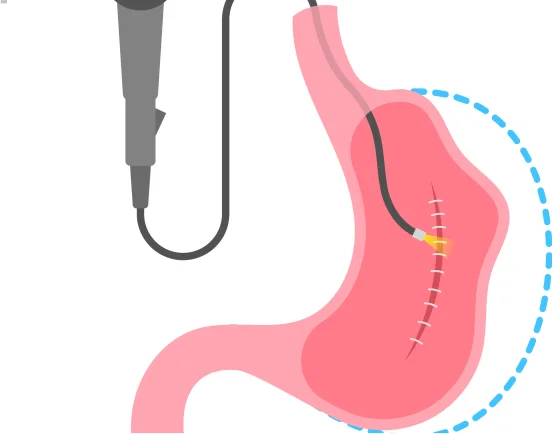Peroral Endoscopic Myotomy (POEM) is an advanced, minimally invasive procedure used primarily to treat the condition known as achalasia, which is a rare, but serious condition that impairs the capacity of the esophagus in transferring foods into stomach. In contrast to conventional open or laparoscopic procedures, POEM offers a non-scarring, non-incision procedure that offers the patient with long-term relief from conditions like trouble swallowing, chestache or regurgitation.
The revolutionary procedure is done by mouth using an endoscope, removing the requirement for stitches or cuts. POEM has seen huge success in recent years because of its efficacy, safety as well as its speedier recovery.
If you or someone else in your family suffers from persistent esophageal discomfort and difficulty swallowing or signs of achalasia knowing more regarding the Peroral Endoscopic Myotomy is a crucial step towards a long-lasting and effective treatment.
Why Peroral Endoscopic Myotomy (POEM)?
POEM is considered to be one among the most efficient treatment options for disorders of the esophageal motility. It stands out because of numerous advantages:
- Minimally Invasive Nature:- Contrary to conventional surgeries, POEM involves no external incisions. This entire process is done endoscopically in the mouth of the patient which results in minimal discomfort and a lower risk of infection and quicker healing.
- High Success Rate:- Clinical studies have revealed that there is a high success rate of 90 percent or more in the treatment of symptoms associated with achalasia and other esophageal diseases. POEM provides lasting relief from symptoms even after years of procedure.
- Quicker Recovery Time:- Patients who have POEM usually resume normal activities in some days. The majority of patients are discharged from the hospital within 24-48 hours following the procedure.
- Suitable for Complex Cases: POEM is particularly beneficial for:
-
Patients who have previously failed treatment or procedures
-
Individuals suffering from complex or spastic forms of Achalasia (Type III)
-
Patients with high risk or who are elderly aren’t the best candidates for surgery open.
Enhanced Quality of Life:-In reducing symptoms such as dysphagia (difficulty swallowing) regurgitation and chest pain, POEM significantly improves general well-being and daily performance.
Symptoms for Peroral Endoscopic Myotomy (POEM)
Although POEM is the method of treatment for patients, those who could be benefited from the procedure usually exhibit these symptoms associated with Achalasia and esophageal issues:
-
Trouble eating (Dysphagia): Feeling of food particles sticking to the chest or throat
-
Regurgitation of food that is not digested
-
Chest discomfort or pain in particular after eating
-
Heartburn that persists or acid reflux
-
Weight loss that is not intentional
-
Cough that is chronic especially in the evening
-
Choking episodes or aspiration especially while asleep
These signs indicate an underlying problem with esophageal motility which peroral Endoscopic Myotomy can treat effectively.
Causes for Peroral Endoscopic Myotomy (POEM)
POEM is typically used to treat ailments that cause the stomach muscles do not relax correctly which results in limited food passage into the stomach. They include:
1. Achalasia
A rare disorder in which it is believed that the lower esophageal and sphincter (LES) fails to relax, leading to a back-up of food. The exact cause is not known but it may be related to the destruction of nerve cells located in the esophagus.
2. Diffuse Esophageal Spasm (DES)
The condition is characterised by inconsistent and uncoordinated movements that occur in the esophageal muscle that can lead to difficulty swallowing and chest pain.
3. Jackhammer Esophagus
Extreme type of DES that causes intensely powerful muscle contractions in the esophagus.
4. Spastic Motility Disorders
Disorders such as Achalasia Type III that affect both the LES and the esophageal organ are affected, usually require an individualized and flexible treatment plan similar to POEM.
Diagnosis for Peroral Endoscopic Myotomy (POEM)
Before making a recommendation for POEM specialists conduct an array of diagnostic tests to confirm the existence and kind of esophageal motility disorder:
1. Esophageal Manometry
The most reliable test, it measures the pressure and the movement in the esophagus as well as LES. It will help to determine if muscles are functioning properly.
2. Barium Swallow (Esophagram)
A study using contrast X-rays that illustrates how food moves through the stomach. It can help identify obstructions or narrowing.
3. Upper Endoscopy (EGD)
Direct visualisation of the esophagus stomach and duodenum to eliminate the presence of tumors or obstructions..
4. pH Monitoring
Examens to determine if there is an abnormality in acid reflux are recommended, especially when GERD is suspected in conjunction with molecular conditions.
A proper diagnosis is crucial for ensuring that that POEM is the best choice for treatment and to rule out other reasons for similar symptoms.
Treatment for Peroral Endoscopic Myotomy (POEM)
When a patient is diagnosed Achalasia or another similar disorder, POEM is performed by a highly skilled gastroenterologist or surgeon who is trained to perform advanced endoscopy.
Step-by-Step Overview of the POEM Procedure:
-
Preparation The patient receives general anesthesia.
-
The Endoscope Injection A thin tubular structure (endoscope) is passed through the mouth into the esophagus.
-
Submucosal Tunnel creation An incision of a small size is made in the esophagus lining in order to create the tunnel.
-
Myotomy The inner circle muscle is cut off to alleviate pressure and restore normal motion.
-
Closure The incision inside is closed with specific clips for endoscopic use.
The whole procedure can take between 1 and 2 hours and the majority of patients released the following day.
Post-Treatment Care:
-
Diet in liquid form for a couple of days, then an slow return gradually to the solid food
-
A regular follow-up to keep track of the progress of the treatment and address any adverse consequences
-
Medicines can be prescribed to treat reflux as a typical adverse effect of POEM.
Conclusion
Peroral Endoscopic Myotomy (POEM) represents a major advancement in the treatment of esophageal motility issues particularly Achalasia. The procedure can be minimally invasive, extremely efficient, and widely accepted as an initial treatment option for patients.
For people who suffer with chronic difficulties swallowing such as chest pain or regurgitation POEM can provide a new way of life–restoring the comfort, function and overall health, without the trauma of conventional procedures.
If you’re suffering from symptoms of achalasia or were classified as suffering from an esophageal dysfunction Consult a physician to determine if the Peroral Endoscopic Myotomy is the best option for you.























